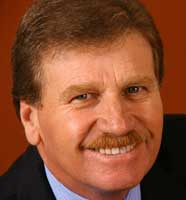Distell is priming its palate for increased business with a world-class sensory laboratory that benchmarks new and established products against competitor offerings on local and international markets.

Gerd Loubser: “In building our sensory laboratory we were able to draw from best-practice examples abroad”.
“The facility is the only one of its kind in the country to offer a qualitative, sensory research capability for wines, spirits and ready to drinks (RTDs),” says Dr Gert Loubser, the company's director of quality management and research. “It has been established to create a better understanding of consumer preferences and needs, and supports our drive to be totally consumer-driven in our operations.”
This investment, made in August 2006, is already bearing fruit as the company continues to grow its brands in export markets in the face of fierce competition. For the last six months of 2007 it reported an 18,4% increase in the volumes of wines sold beyond Africa. International spirit volumes exported over the same period rose almost 12%.
The company, recently rated the 10th biggest wine marketer in the world by Impact Databank in the US, produces 20 million cases of wine a year. Its cream liqueur Amarula is currently South Africa's most widely distributed alcoholic beverage, and its cider brand Savanna is a domestic market leader. Savanna has fast been building a support base in the UK, while also gaining traction in a selection of European markets.
Loubser points out that the decision to invest in building a leading-edge sensory capability follows that of major wine companies such as Constellation, E&J Gallo and Forster's Wine Estates in the US, who successfully use sensory research as a critical product development tool. “In building our sensory laboratory we were able to draw from best-practice examples abroad. It has been designed and equipped to provide us with a qualitative sensory map of products in the market where we operate. Findings are then applied to identify potential gaps to fill with new offerings or with pointers to enhance existing products,” says Loubser.
Dr Marius Lambrechts, the company's group research manager, played a key role in the establishment of the new facility, and explains, “In creating a fingerprint of each product under scrutiny, we not only chemically analyse it but document the various facets of its sensory profile such as aroma, flavour, taste and mouthfeel, all critically important in contributing to drinking enjoyment.
“When it comes to wines, we plan our products in the vineyards and determine viticultural management protocols in line with the intended style and pricing points. Based on sensory mapping, we can highlight particular characteristics we want to achieve and use appropriate viticultural and winemaking techniques to ensure the outcome matches consumer preferences.”
Lambrechts says a central feature of the extremely sophisticated, 100 m2 facility, is a series of computerised, isolated, individual tasting cubicles with controlled air and lighting, where highly trained tasters evaluate and record the beverages put before them in terms of aroma, taste and mouthfeel. Potential tasters undergo a rigorous screening process to determine their suitability. This is based on their sensory capacity to readily discern a variety of tastes and their ability to verbally describe what they experience.
Successful candidates receive extensive training to operate as what Lambrechts calls “objective measuring tools”. Their evaluations are statistically mapped and then overlaid with the chemical analyses of the products under scrutiny, allowing for a scientific differentiation between products.
This technique, when coupled with consumer preference data, provides an invaluable tool to winemakers and developers of other new products to meet consumer needs, says Loubser.
The sensory facility forms part of the company's quality management and research department and works very closely with Distell's marketing and production functions.



























![Today, Halo and Demographica announce a new specialist agency, Second Rodeo]], headed up by Mike Stopforth (left). Dean Oelschig, managing partner and founder of Halo (right) says they will work as a group but ultimately, each agency will be an individual specialist](https://biz-file.com/c/2505/772543-64x64.jpg?2)

